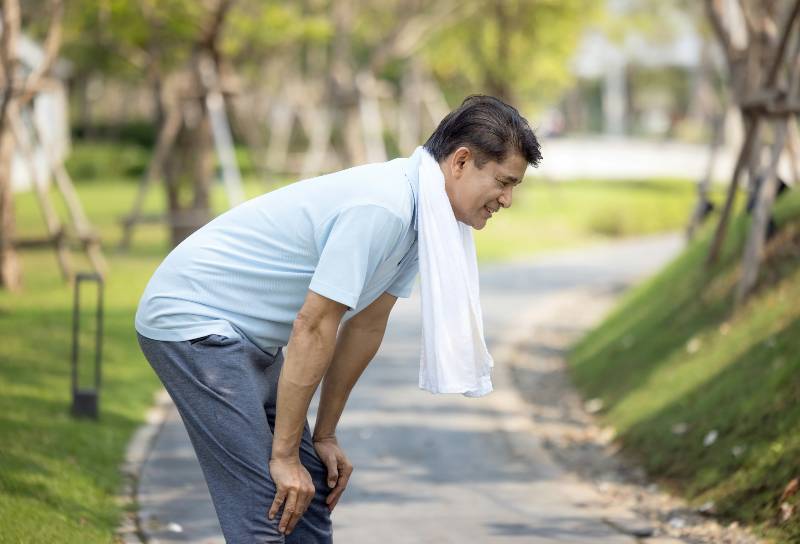You may have noticed it yourself – that peculiar sensation of heaviness in your legs after a good workout session. It’s not just about feeling tired; it’s as if your legs have turned into lead, making even the simplest movements feel laborious.
This phenomenon, though common, can sometimes leave you puzzled and concerned. Let’s see why your legs feel so heavy after exercising and what you can do to alleviate this sensation.
Why Do Your Legs Feel Heavy After Working Out?
Several factors can contribute to the feeling of heavy legs after a workout. While most reasons are normal and usually not a cause for concern, understanding these can help you take proactive steps to prevent or minimize the discomfort.
1. Exercising Too Hard
Pushing your body beyond its limits can certainly leave you feeling the repercussions, and heavy legs are a common one.
When you exercise harder or longer than usual, or without sufficient rest between sessions, your muscles can become overworked. This overstressing of the muscles can lead to fatigue, which manifests as that all-too-familiar heaviness.
2. Lactic Acid Buildup
During intense physical activity, your body produces lactic acid as a byproduct of energy metabolism. When lactic acid accumulates in the muscles faster than it can be cleared away, it can lead to a sensation known as lactic acid buildup.
Lactic acid buildup can cause your muscles to feel sore, tired, and heavy. Although this process is a natural part of exercise, especially during high-intensity workouts, it can be quite uncomfortable.
3. Inflammation
Exercise-induced muscle damage is not unusual, especially after particularly strenuous or new activities. Such damage, while temporary and part of building stronger muscles, can cause inflammation.
Along with inflammation, there’s often a build-up of fluid within the muscles, contributing to a feeling of heaviness and temporary weight gain.
You may not know that this is your body’s way of protecting and healing the muscles, but it can make your legs feel unusually heavy.
4. Chronic Venous Insufficiency
Chronic venous insufficiency (CVI) is a condition where the valves in the leg veins that are supposed to prevent blood from flowing backward don’t work effectively.
CVI can cause blood to pool in the legs, leading to symptoms like swelling, aching, and a heavy feeling in the legs, especially after physical activities. While CVI requires medical diagnosis and treatment, recognizing heavy legs as a potential early sign can be crucial to managing the condition.
5. Poor Circulation
Poor blood circulation, or venous insufficiency, is when the blood flow from the legs back to the heart is inadequate. It can happen for a variety of reasons, including prolonged sitting or standing, certain medical conditions, or even as a result of intense workout sessions.
When circulation is compromised, it can lead to a feeling of heaviness in the legs because the blood starts to pool, rather than efficiently returning to the heart. This sensation often accompanies symptoms like swelling, numbness, and in some cases, a noticeable change in skin color.
6. Dehydration
Intense workouts can lead to significant fluid loss through sweat. Dehydration affects your body’s ability to pump blood efficiently, leading to poor circulation which, in turn, can make your legs feel heavy.
Ensuring you are adequately hydrated before, during, and after your workout is crucial to help prevent this sensation.
7. Nutrient Deficiency
Your muscles need a steady supply of nutrients like potassium, magnesium, and calcium to function correctly. A deficiency in these essential minerals can lead to muscle cramps and a heavy feeling in your legs.
These nutrients facilitate various bodily functions, including muscle contractions and blood flow, underscoring the importance of maintaining a balanced diet to support your exercise routine.
How To Relieve Heavy Legs After Working Out
Alleviating the sensation of heavy legs after exercising can usually be achieved with a few simple measures. These tips not only help prevent heavy legs but also promote overall muscle recovery and well-being.
Drink Water Regularly
Hydration is key. As mentioned, dehydration can significantly contribute to the sensation of heavy legs by affecting blood circulation.
Make sure to drink plenty of water before, during, and after your workout to replace the fluids lost through sweat and to keep your muscles and circulation system working optimally.
Vary Your Positions And Move Around
If your workout or job involves standing or sitting for extended periods, make it a point to change positions frequently.
Take short breaks to walk around; this can help stimulate blood flow and prevent blood from pooling in your legs, thereby avoiding that heavy leg feeling.
Wiggle Your Toes To Activate Blood Circulation
Something as simple as wiggling your toes or doing ankle circles can help activate the muscles in your lower legs, aiding in blood circulation.
Perform these small movements, especially if you’ve been in one position for a while, to keep the blood flowing smoothly and prevent heaviness.
Place Your Legs On A Cushion So That They Are Slightly Elevated
Elevating your legs can aid in draining excess fluid that may have built up during your workout, thus reducing inflammation and the feeling of heaviness.
Try to elevate your legs above the level of your heart for 15 to 20 minutes after exercising. This position enhances venous return and can be particularly relaxing if you’ve been on your feet all day or after a long run.
Avoid Wearing Tight Clothing
Tight clothing, especially around your waist and legs, can restrict blood flow and exacerbate the feeling of heavy legs. Opt for loose-fitting, comfortable clothes after your workout to encourage better circulation.
Compression garments are an exception; when properly fitted, they can actually improve blood flow and reduce muscle soreness by offering graduated compression that encourages circulation.
Avoid Wearing High Heels
High heels can negatively affect blood circulation in your legs and can also lead to muscle strain and fatigue.
After a workout, give your legs and feet a break by wearing flat, comfortable shoes that support natural walking and standing posture. This reduces strain on your leg muscles and blood vessels, helping to keep that heavy leg sensation at bay.
Stretch And Cool Down Properly After Exercise
A proper cool-down phase after your workout is crucial. It aids in gradually decreasing your heart rate and promotes blood circulation, which can prevent the pooling of blood in your legs.
Incorporate stretches that target your leg muscles, such as calf stretches, hamstring stretches, and quadriceps stretches. Holding each stretch for at least 30 seconds can help in effectively reducing muscle tightness and preventing fluid build-up, thereby alleviating the sensation of heavy legs.
Foam Rolling
Foam rolling can be highly beneficial for relieving muscle tightness and improving blood circulation in your legs. This self-myofascial release technique helps in breaking up muscle knots and promoting blood flow to specific areas.
Spend a few minutes rolling out your calves, hamstrings, quadriceps, and IT bands to help your leg muscles recover faster and feel lighter.
Incorporate Active Recovery
On the days following intense workouts, consider engaging in active recovery activities. Activities like walking, cycling at a leisurely pace, or doing yoga can enhance blood circulation without putting excessive strain on your muscles.
Active recovery helps in flushing out lactic acid and other metabolic waste from your muscles, speeding up the recovery process and reducing the sensation of heaviness.
Pay Attention To Nutrition
Your diet plays a significant role in muscle recovery and blood circulation. Eating a balanced diet rich in vitamins, minerals, and antioxidants can significantly influence how your body responds to and recovers from exercise.
Foods high in potassium and magnesium, such as bananas, avocados, and leafy greens, help regulate fluid balance and muscle contractions, which can alleviate the heavy leg sensation.
Also, incorporating protein-rich foods like chicken, fish, beans, and tofu can support muscle repair and reduce inflammation. Staying hydrated and maintaining a balanced intake of electrolytes is equally important to prevent muscle cramps and fatigue.
Get Enough Rest
Adequate rest is crucial for muscle recovery. Overworking your body without giving it time to recover can lead to chronic fatigue and the persistent feeling of heavy legs.
Ensure you’re getting enough sleep and consider taking rest days between intense workout sessions. This allows your body to repair and strengthen muscles, which reduces the feeling of heaviness and prepares your legs for your next workout.
Listen To Your Body
Finally, it’s essential to listen to your body and understand its limits. If the feeling of heavy legs is accompanied by pain, swelling, or does not improve with rest and hydration, it may be time to consult a healthcare professional.
Seek Professional Advice
If you’ve tried these mentioned suggestions and still experience heavy legs regularly, it might be beneficial to seek advice from a fitness professional or physiotherapist. They can analyze your workout routine, posture, and muscle balance to identify any areas that might be contributing to the issue.
Sometimes, slight adjustments to your workout intensity, duration, or the types of exercises you’re doing can make a significant difference. A physiotherapist may also provide targeted exercises or manual therapy techniques to address specific concerns.
Conclusion
Feeling heavy in the legs after workouts is a common experience for many, often resulting from factors like exercise intensity, lactic acid buildup, hydration status, and muscle recovery processes.
While generally not a cause for concern, understanding why it happens can help you take steps to minimize discomfort and improve your recovery time.
Implementing practices such as proper hydration, stretching, varying your movements, and paying attention to nutrition and rest can help alleviate heavy legs.




